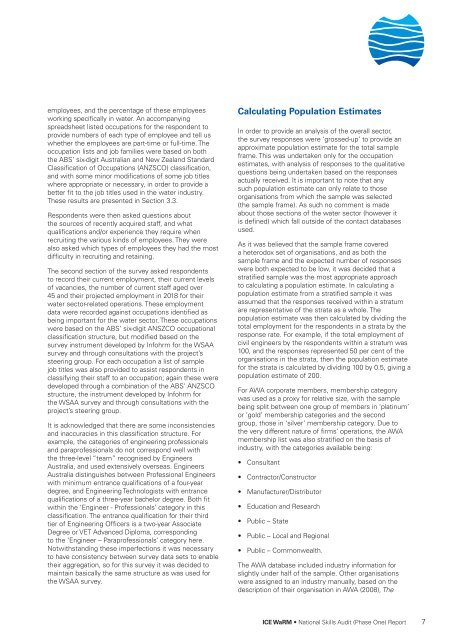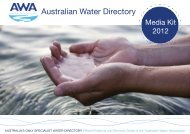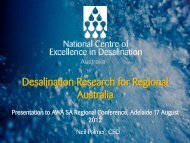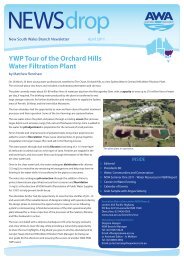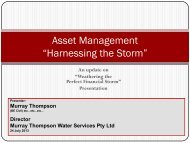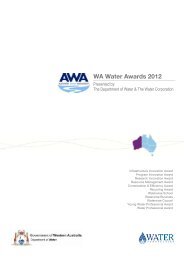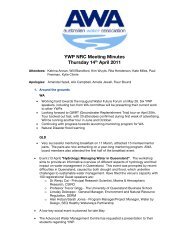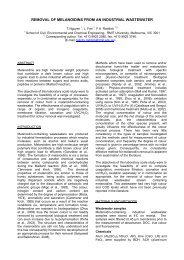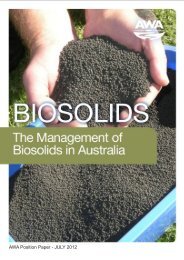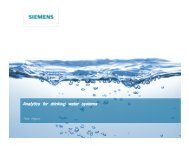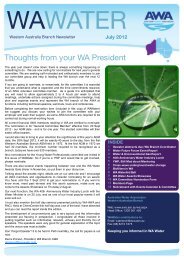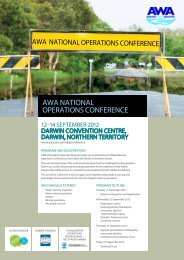National Water Skills Audit - Australian Water Association
National Water Skills Audit - Australian Water Association
National Water Skills Audit - Australian Water Association
- No tags were found...
You also want an ePaper? Increase the reach of your titles
YUMPU automatically turns print PDFs into web optimized ePapers that Google loves.
employees, and the percentage of these employeesworking specifically in water. An accompanyingspreadsheet listed occupations for the respondent toprovide numbers of each type of employee and tell uswhether the employees are part-time or full-time. Theoccupation lists and job families were based on boththe ABS’ six-digit <strong>Australian</strong> and New Zealand StandardClassification of Occupations (ANZSCO) classification,and with some minor modifications of some job titleswhere appropriate or necessary, in order to provide abetter fit to the job titles used in the water industry.These results are presented in Section 3.3.Respondents were then asked questions aboutthe sources of recently acquired staff, and whatqualifications and/or experience they require whenrecruiting the various kinds of employees. They werealso asked which types of employees they had the mostdifficulty in recruiting and retaining.The second section of the survey asked respondentsto record their current employment, their current levelsof vacancies, the number of current staff aged over45 and their projected employment in 2018 for theirwater sector-related operations. These employmentdata were recorded against occupations identified asbeing important for the water sector. These occupationswere based on the ABS’ six-digit ANSZCO occupationalclassification structure, but modified based on thesurvey instrument developed by Infohrm for the WSAAsurvey and through consultations with the project’ssteering group. For each occupation a list of samplejob titles was also provided to assist respondents inclassifying their staff to an occupation; again these weredeveloped through a combination of the ABS’ ANZSCOstructure, the instrument developed by Infohrm forthe WSAA survey and through consultations with theproject’s steering group.It is acknowledged that there are some inconsistenciesand inaccuracies in this classification structure. Forexample, the categories of engineering professionalsand paraprofessionals do not correspond well withthe three-level “team” recognised by EngineersAustralia, and used extensively overseas. EngineersAustralia distinguishes between Professional Engineerswith minimum entrance qualifications of a four-yeardegree, and Engineering Technologists with entrancequalifications of a three-year bachelor degree. Both fitwithin the ‘Engineer - Professionals’ category in thisclassification. The entrance qualification for their thirdtier of Engineering Officers is a two-year AssociateDegree or VET Advanced Diploma, correspondingto the ‘Engineer – Paraprofessionals’ category here.Notwithstanding these imperfections it was necessaryto have consistency between survey data sets to enabletheir aggregation, so for this survey it was decided tomaintain basically the same structure as was used forthe WSAA survey.Calculating Population EstimatesIn order to provide an analysis of the overall sector,the survey responses were ‘grossed-up’ to provide anapproximate population estimate for the total sampleframe. This was undertaken only for the occupationestimates, with analysis of responses to the qualitativequestions being undertaken based on the responsesactually received. It is important to note that anysuch population estimate can only relate to thoseorganisations from which the sample was selected(the sample frame). As such no comment is madeabout those sections of the water sector (however itis defined) which fall outside of the contact databasesused.As it was believed that the sample frame covereda heterodox set of organisations, and as both thesample frame and the expected number of responseswere both expected to be low, it was decided that astratified sample was the most appropriate approachto calculating a population estimate. In calculating apopulation estimate from a stratified sample it wasassumed that the responses received within a stratumare representative of the strata as a whole. Thepopulation estimate was then calculated by dividing thetotal employment for the respondents in a strata by theresponse rate. For example, if the total employment ofcivil engineers by the respondents within a stratum was100, and the responses represented 50 per cent of theorganisations in the strata, then the population estimatefor the strata is calculated by dividing 100 by 0.5, giving apopulation estimate of 200.For AWA corporate members, membership categorywas used as a proxy for relative size, with the samplebeing split between one group of members in ‘platinum’or ‘gold’ membership categories and the secondgroup, those in ‘silver’ membership category. Due tothe very different nature of firms’ operations, the AWAmembership list was also stratified on the basis ofindustry, with the categories available being:• Consultant• Contractor/Constructor• Manufacturer/Distributor• Education and Research• Public – State• Public – Local and Regional• Public – Commonwealth.The AWA database included industry information forslightly under half of the sample. Other organisationswere assigned to an industry manually, based on thedescription of their organisation in AWA (2008), TheICE WaRM • <strong>National</strong> <strong>Skills</strong> <strong>Audit</strong> (Phase One) Report


